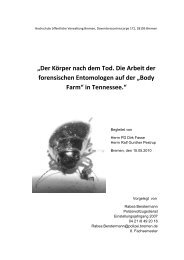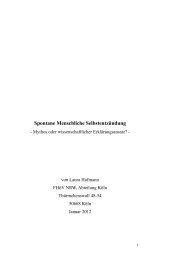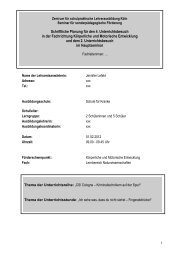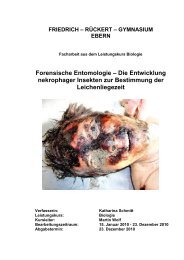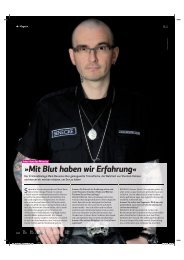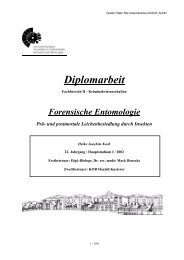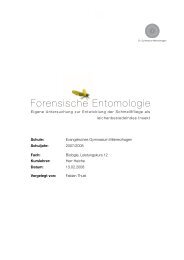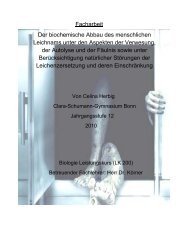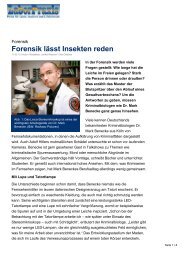A brief survey of the history of forensic entomology - Wiki2.benecke ...
A brief survey of the history of forensic entomology - Wiki2.benecke ...
A brief survey of the history of forensic entomology - Wiki2.benecke ...
Create successful ePaper yourself
Turn your PDF publications into a flip-book with our unique Google optimized e-Paper software.
26 MARK BENECKE<br />
5. Turn <strong>of</strong> <strong>the</strong> century<br />
Previous <strong>forensic</strong> insect studies by <strong>the</strong> German<br />
doctors KLINGELHÖFFER and MASCHKA,<br />
and <strong>the</strong> <strong>forensic</strong> pathologist S. VON HOROSZ-<br />
KIEWICZ from Krakow University (<strong>the</strong>n<br />
Austria, now Poland), had focused on <strong>the</strong><br />
bite patterns <strong>of</strong> cockroaches and ants. KLIN-<br />
GELHÖFFER (1898), a district medical doctor<br />
responsible for <strong>the</strong> Frankfurt area, relates <strong>the</strong><br />
case <strong>of</strong> a poor family, whose nine month old,<br />
sickly baby died on May 26, 1889, and was<br />
autopsied three days later, on May 29. In <strong>the</strong><br />
meantime, <strong>the</strong> local “doctor responsible for<br />
<strong>the</strong> poor” had filed a report to <strong>the</strong> police because<br />
he had observed patches in <strong>the</strong> face <strong>of</strong><br />
<strong>the</strong> child, leading to <strong>the</strong> fa<strong>the</strong>r’s arrest. During<br />
<strong>the</strong> resulting autopsy, <strong>the</strong> “patches” were<br />
noted on <strong>the</strong> nose and lips and to proceed<br />
downwards from <strong>the</strong> child’s mouth. The<br />
tongue was not discolored, but bleeding on<br />
<strong>the</strong> tip. Of particular interest to <strong>the</strong> police<br />
was confirmation <strong>of</strong> <strong>the</strong>ir suspicions that <strong>the</strong><br />
fa<strong>the</strong>r had tried to make <strong>the</strong> child drink sulphuric<br />
acid, a common method <strong>of</strong> poisoning<br />
at that time. However, KLINGELHÖFFER<br />
found no signs <strong>of</strong> poisoning, and concluded<br />
that <strong>the</strong> abrasion-like patterns had most<br />
likely been caused by cockroaches. The fa<strong>the</strong>r<br />
was released after three weeks in prison (KLIN-<br />
GELHÖFFER 1898).<br />
HOROSZKIEWICZ (1902) dealt with a similar<br />
case, in which a child was autopsied in April,<br />
1899. The autopsy found no internal signs<br />
<strong>of</strong> violent death, however, numerous abrasions<br />
could be seen on <strong>the</strong> nose, cheeks,<br />
lips and chin, with more obvious marks on<br />
<strong>the</strong> surface <strong>of</strong> <strong>the</strong> neck and backside <strong>of</strong> <strong>the</strong><br />
left hand, fingers, genitals and <strong>the</strong> inner thighs.<br />
When questioned by HOROSZKIEWICZ, <strong>the</strong><br />
mo<strong>the</strong>r stated that when she came home<br />
from preparing for <strong>the</strong> funeral, <strong>the</strong> body <strong>of</strong><br />
her child had looked as if it was covered with<br />
a black shroud (“mit einem schwarzen Leichentuche<br />
bedeckt”, p. 236) <strong>of</strong> cockroaches,<br />
but she did not see any abrasions at that time.<br />
To verify whe<strong>the</strong>r <strong>the</strong> cockroaches could be<br />
<strong>the</strong> sole cause for <strong>the</strong> abrasions, HOROSZ-<br />
KIEWICZ put pieces <strong>of</strong> fresh tissue from human<br />
corpses in glasses filled with cockroaches.<br />
While no obvious signs <strong>of</strong> cockroach feeding<br />
were apparent immediately after <strong>the</strong> feeding<br />
activity, <strong>the</strong>y became visible when <strong>the</strong> skin<br />
dried, explaining why <strong>the</strong> mo<strong>the</strong>r had not<br />
seen <strong>the</strong> abrasions but <strong>the</strong> medical examiners<br />
had.<br />
Similar cases were reported by medical examiner<br />
MASCHKA (1881) from Austria who became<br />
involved in high pr<strong>of</strong>ile cases in <strong>the</strong><br />
modern sense <strong>of</strong> <strong>the</strong> phrase. In one case, he<br />
found abrasions on a child whose body was<br />
discovered in a well. It was believed that a<br />
sexual <strong>of</strong>fender may have abused <strong>the</strong> child<br />
and <strong>the</strong>n strangled, or throttled, it before<br />
throwing it in <strong>the</strong> well. MASCHKA, however,<br />
concluded that <strong>the</strong> lesions must have been<br />
caused by arthropods. In ano<strong>the</strong>r case, it was<br />
thought that a fa<strong>the</strong>r may have killed his threeday-old<br />
child by forcing it to drink sulphuric<br />
acid. The fa<strong>the</strong>r, however, stated that he had<br />
put <strong>the</strong> child, after it had died <strong>of</strong> natural<br />
causes, near <strong>the</strong> window at 22:00 hrs on April<br />
14, 1880. He reported that on 04:00 hrs <strong>the</strong><br />
next day, <strong>the</strong> child’s head, located under a blanket,<br />
was already covered with ants. MASCHKA’s<br />
findings at autopsy were consistent with <strong>the</strong><br />
fa<strong>the</strong>r’s account.<br />
Ano<strong>the</strong>r experimental account was given<br />
by E. RITTER VON NIEZABITOWSKI (1902), also<br />
a medical examiner at <strong>the</strong> Medico-Legal Institute<br />
<strong>of</strong> Krakow University. His experiments<br />
were performed from May, 1899, to September,<br />
1900, using aborted fetuses and cat, fox,<br />
rat, mole and calf cadavers that he put on <strong>the</strong><br />
windowsill in <strong>the</strong> institute as well as in a nearby<br />
vegetable garden. His observations dealt primarily<br />
with flies: calliphorids, Lucilia caesar,<br />
Sarcophaga carnaria, and “Pyophila nigriceps”<br />
(most likely, cheese skippers Piophila casei); but it<br />
also included beetles, mostly Silpha, Necrophorus<br />
or Dermestes. His important contribution to <strong>the</strong><br />
field was <strong>the</strong> experimental pro<strong>of</strong> that human<br />
corpses share <strong>the</strong> same fauna with animal<br />
corpses, both vertebrate and invertebrate.



